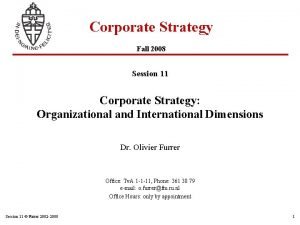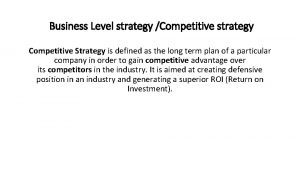Corporate Level Strategy Chapter 6 What is a











- Slides: 11

Corporate Level Strategy Chapter 6

What is a Corporate Level Strategy ? • It is the strategy which is used by firms when they want to diversify their operations from a single business competing in a single market into several product markets and thus several businesses • A corporate level strategy specifies actions a firm takes to gain a competitive advantage by selecting and managing a group of different businesses competing in different product markets

Issues with Corporate level strategies • Corporate level strategies are concerned with two types of issues 1. In what product markets and businesses the firm should compete ? 2. How should corporate headquarters manage those businesses ?

Issues with Corporate level strategies • Evidence suggests that a corporate level strategy’s value is ultimately determined by the degree to which the business in the portfolio are worth more under the management of the company than they would be under any other ownership • Thus an effective corporate level strategy creates, across all of a firm’s businesses, aggregate returns that exceed what those returns would be without the strategy • Product diversification is the most primary form of corporate level strategy

Levels of Diversification • 1. Low levels of diversification Single business – 95% or more revenue coming from single business 2. Dominant business – Between 70%-90% revenues coming from single business 3. Moderate to High level of Diversification 4. Related Constrained – Less than 70% of revenue comes from the dominant business & all businesses share linkages of technology, distribution etc 5. Related linked – Less than 70% revenue comes from dominant businesses and there are limited linkages 6. Very high level of Diversification 1. Unrelated – Less than 70% revenues from dominant business and there are no linkages

Reasons for Diversification • Value creating diversification 1. Economies of Scope (related diversification a. Sharing activities b. Transferring core competencies 2. Market Power (related diversification) a. Blocking competitors through multipoint competition b. Vertical Integration 3. Financial Economies (unrelated diversification) a. Efficient internal capital allocation b. Business restructuring

Reasons for Diversification Value Neutral Diversification 1. Antitrust regulation 2. Tax laws 3. Low performance 4. Uncertain future cash flows 5. Risk reduction for firm 6. Tangible resources 7. Intangible resources Value Reducing Diversification 1. Diversifying managerial employment risk 2. Increasing managerial compensation

Value creating diversification • Economies of scope are cost savings that the firm creates by successfully sharing some of its resources and capabilities or transferring one or more corporate level core competencies that were developed in one of its businesses to another of its businesses

Value creating diversification • Economies of scope happen through two basic types of operational economies 1. Sharing activities – operational relatedness – sharing of tangible resources like office, manufacturing units or warehouse 2. Transferring corporate level core competencies – corporate relatedness – transfer of know how of a process – intangible resources from one business unit to another is corporate relatedness

Value creating diversification • Market power – it exists when a firm is able to sell its products above the existing competitive level or to reduce the costs of its primary and support activities below the competitive level or both • Multi competition – it exists when two or more diversified firms simultaneously compete in the same product areas or geographic markets • Vertical integration – it exists when a company produces its own inputs (backward integration) or owns its source of output distribution ( forward integration)

Unrelated diversification • Unrelated diversification create value through two types of financial economies 1. Efficient internal capital market allocation 2. Restructuring of assets Financial economies are cost savings realized through improved allocation of financial resources based on investments inside or outside the firm
 Business strategy vs corporate strategy
Business strategy vs corporate strategy Strategy formulation corporate strategy
Strategy formulation corporate strategy Organizational strategy types
Organizational strategy types Strategy map hr scorecard digital dashboard
Strategy map hr scorecard digital dashboard A multidomestic corporate-level strategy is one in which:
A multidomestic corporate-level strategy is one in which: Corporate level cooperative strategy
Corporate level cooperative strategy Corporate level cooperative strategy
Corporate level cooperative strategy Corporate level strategy types
Corporate level strategy types Business-level strategy
Business-level strategy Corporate level cooperative strategy
Corporate level cooperative strategy Formulating corporate level strategy
Formulating corporate level strategy Types of corporate level strategy
Types of corporate level strategy




















